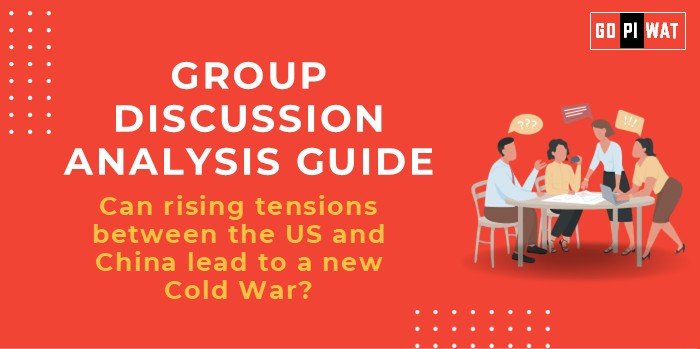📋 Group Discussion Analysis Guide: Can Rising Tensions Between the US and China Lead to a New Cold War?
🌐 Introduction to the Topic
📖 Opening Context
The escalating strategic competition between the United States and China is reshaping the global geopolitical landscape, evoking parallels with the Cold War era. This dynamic holds profound implications for international relations, trade, and security.
📜 Topic Background
Since the end of the Cold War, the US-China relationship has evolved from partnership to rivalry. Recent flashpoints, including trade disputes, military confrontations in the South China Sea, and tech wars involving 5G and semiconductors, underscore the tensions. The question arises: are these developments leading to a new Cold War?
📊 Quick Facts and Key Statistics
- 💰 US-China Trade Value: $690 billion in 2022, highlighting economic interdependence amidst rivalry.
- 🛡️ Defense Spending: US – $877 billion; China – $292 billion (2022 SIPRI), reflecting growing militarization.
- 🌍 Belt and Road Initiative (BRI): China’s BRI spans 140 countries, challenging US influence in global development.
- ⚔️ Taiwan Strait Confrontations: Over 20 incidents of near-military engagements reported in 2023.
🤝 Stakeholders and Their Roles
- 🏛️ Governments: US (strategic containment policies) and China (regional dominance).
- 🌐 Alliances: NATO, QUAD, and AUKUS counter China’s influence.
- 📢 Global Organizations: WTO, UN, mediating trade and diplomatic conflicts.
- 💼 Private Sector: Tech giants like Huawei (China) and Apple (US) face repercussions of decoupling.
- 👥 Citizens: Populations are affected by economic sanctions, supply chain disruptions, and media narratives.
🏆 Achievements and Challenges
✨ Achievements
- 🤝 US-China Collaborations: Climate change and trade agreements (prior to 2017).
- 📈 Economic Growth: Interdependence has driven the largest trading partnership globally.
⚠️ Challenges
- 💰 Trade Wars: $360 billion in tariffs since 2018.
- 🛡️ Military Build-Up: Escalation in arms race and regional skirmishes.
- 📉 Tech Decoupling: Supply chain disruptions in critical industries like semiconductors.
🌍 Global Comparisons
- 📖 Historical Context: Similar Cold War patterns emerge in US-Russia relations during the 20th century.
- 📚 Case Study: Taiwan Strait standoff as a flashpoint for potential conflict.
💡 Structured Arguments for Discussion
- 🛠️ Supporting Stance: “The economic, military, and ideological rivalry mirrors Cold War dynamics, as evident in the arms race and tech decoupling.”
- 🛡️ Opposing Stance: “Unlike the Cold War, the economic interdependence between the US and China acts as a stabilizing factor, preventing outright confrontation.”
- ⚖️ Balanced Perspective: “While tensions escalate, the absence of bloc-based alignments and nuclear brinkmanship distinguishes it from the Cold War.”
🎯 Effective Discussion Approaches
🔑 Opening Approaches
- 📈 Highlight Economic Interdependence: “US-China trade reached $690 billion in 2022 despite rising tensions.”
- 🌍 Discuss Taiwan’s Geopolitical Significance: “The Taiwan Strait is emerging as a key flashpoint in this rivalry.”
- 🤝 Reference Recent Diplomatic Engagements: “Efforts at dialogue on climate and trade offer glimmers of hope.”
⚙️ Counter-Argument Handling
- 🔄 Acknowledge: “Trade is a stabilizing force but doesn’t negate escalating security concerns.”
- ✅ Rebuttal: “Alternative conflict resolution models, like US-EU post-World War II cooperation, could inform strategies.”
🧠 Strategic Analysis of Strengths and Weaknesses
SWOT Analysis:
- 💪 Strengths: Global influence and economic power; technological advancements driving dominance.
- 🛠️ Weaknesses: Mutual over-reliance on trade; domestic challenges like public dissent (China) and political polarization (US).
- 🌟 Opportunities: Mediation in global conflicts; tech collaboration for mutual benefits.
- ⚠️ Threats: Military miscalculations; economic decoupling exacerbating global recession risks.
🏫 Connecting with B-School Applications
📚 Real-World Applications
- 🌍 Exploring topics like global supply chains, geopolitical risks, and diplomacy in B-school projects.
🎓 Sample Interview Questions
- ❓ “How can businesses mitigate risks from US-China trade tensions?”
- ❓ “Evaluate the role of multinational corporations in navigating US-China dynamics.”
💡 Insights for Students
- 📈 Understanding geopolitical strategy for global business.
- 🛠️ Analyzing risks in international supply chains.


